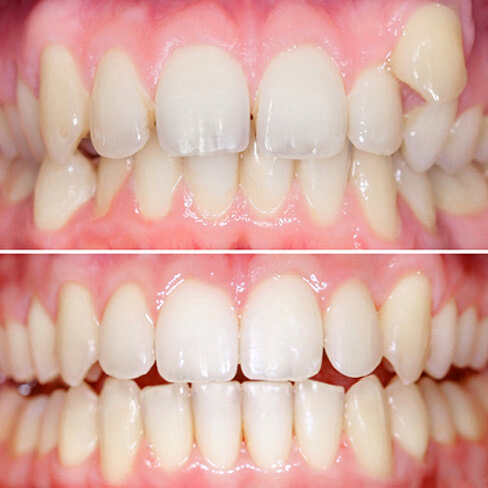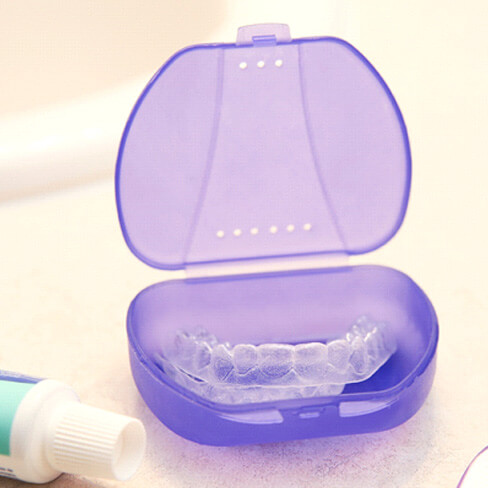One of the biggest hurdles for adult orthodontics is the look and feel of wearing metal brackets and wire braces. Most adults would prefer to avoid this path if possible. Invisalign clear braces from our Buda, TX dental team offers a desirable solution by using clear, removable trays that offer a metal-free orthodontic solution while also allowing easier access for brushing and flossing during the journey to a straighter smile! If you want to learn more about this discreet teeth-straightening service, then read on.
Why Choose Buda Dental Professionals for Invisalign Clear Braces?
- Personalized Relationships with Each Patient
- Fully Customized Treatment Plans
- Convenient, Comfortable Clear Aligners
How Invisalign Works
To move your teeth from their current positions to their ideal positions, one of our dedicated Buda dentists will use a series of custom-made, comfortable, and see-through aligners. During the process, there can be mild discomfort as you transition from each tray. The good news is that the soreness is very minimal, typically only lasts for a day, and can be alleviated with practices like sticking to soft foods in the interim. The entire process can take as little as 3 months or as long as 18 months, and we will give you retainers once you are finished to maintain the new position of your teeth.
Indications for Invisalign
Invisalign has helped more than 12 million patients achieve healthier, happier smiles – and you could be one of them! Although candidacy is determined on a case-by-case basis, the clear aligners are often used to address the following orthodontic problems:
Crowded Teeth
Since overlapped teeth are difficult to clean, straightening them can reduce your risk of tooth decay and gum disease. Furthermore, crooked teeth can wear faster over time during the normal act of chewing food. By moving teeth into a stable position, the wear pattern can be reduced significantly.
Gaps Between Teeth
Spaced-out teeth can also trap food particles, plaque, and the like, increasing your chances of developing a serious oral health concern. The good news is that Invisalign can gradually guide your teeth closer and closer together so that the look, health, and function of your smile are improved!
Bite Alignment
In addition to improving the position of your teeth, Invisalign can improve the alignment of your bite. Better positioning allows the teeth and jaw joints to function more efficiently, helping with the management of TMJ issues and potentially preventing future problems.
The Benefits of Invisalign
There isn’t just one benefit of Invisalign; there are several! First, you can remove your aligners to eat and brush your teeth, which means that you won’t have to worry about adjusting your diet or your oral hygiene regimen. It’s also worth mentioning that the average treatment timeline is only 12-18 months, while traditional braces can take well over 24. And, of course, using Invisalign to move teeth can discreetly give you a smile that looks both beautiful and natural.
How Much Does Invisalign Cost?
In short, there isn’t a flat fee. If you’re interested in getting a price estimate, then we recommend scheduling an appointment with our Buda dental team! That way, we can assess the complexity of your case, learn more about your oral health, and determine how many aligners are needed. Then, we can create your treatment plan and provide you with an estimate of the cost.
Understanding the Cost of Invisalign
One of the reasons that Invisalign is so effective is that every aspect of the treatment will be customized to suit your needs. While this adds a lot to the efficacy of the procedure, it also means that it’s a little bit difficult to tell you precisely what the treatment will cost without meeting you first.
However, if you’re interested in learning more about what your care will cost, here are a few guidelines that you could keep in mind.
Factors that Affect the Cost of Invisalign

What your Invisalign is going to cost will depend on a few factors, so if you’re trying to budget for your treatment there are a few things you may want to consider.
Generally speaking, the longer your treatment takes the more expensive it will be. This means more trips to the dentist’s office, as well as more trays in order to get your teeth into the position they’re hoping for.
Your Invisalign treatment will take longer if your teeth are severely misaligned, or if you struggle to wear your aligner as much as you should.
Invisalign VS Mail-In Aligners: Which Costs More?

If you’ve looked into clear aligners, you’ve probably noticed that there are some companies claiming to offer mail-in in equivalents to Invisalign. This requires you to take your own impressions of your teeth and send them in to one of the few companies that offer this service, ideally skirting the need for a dentist’s assistance.
However, the fact is that taking a DIY approach to dentistry presents challenges. For one, taking a perfect impression of your teeth is difficult, which means that it’s possible for there to be errors that affect the fit of your aligners. You might also have oral health problems like cavities that could cause complications for your Invisalign treatment.
A combination of each of these factors leads mail-in aligners to be riskier than clear aligners you get from a dentist. For this reason, it’s strongly recommended that you see a professional if you’re interested in straightening your teeth.
Does Dental Insurance Cover Invisalign?

This varies heavily from plan to plan. Not every plan makes allowances for orthodontics in general, and even if it is, Invisalign isn’t necessarily considered to be a part of that. For that reason, it’s even more important than usual to consult directly with your dental plan to ensure that you’re getting the most out of your coverage.
If you don’t have insurance, or if yours doesn’t cover Invisalign, there are other options available to you that can make the care you get affordable. Give us a call and we’ll be happy to help you navigate them.
Invisalign FAQs
Invisalign aligners are made of a thin, transparent plastic that fits tightly over the teeth. They’re almost invisible while you’re wearing them, especially if you make an effort to keep them clean. The fact is that people will have a lot of difficulty telling that you’re wearing anything on your teeth unless you tell them. If you take the time to thoroughly clean your aligners each day and avoid anything that could discolor your trays, you can expect your trays to be nearly invisible.
Once you’re finished with the last set of aligners in your series, we’ll take a look at your smile in order to make sure that your teeth are where you’d like them to be. If you still need to straighten out your teeth a bit, we may outfit you with a set of adjustment trays to finish up your treatment.
Otherwise, our aim will be to simply keep your newly aligned teeth in place, which will involve you wearing a retainer. How long you’ll need to do this and how frequently you’ll need to wear your them will depend on you, and we’ll be able to give you more specialized advice when we meet you in person.
While Invisalign aligners are a made of a thin, durable plastic, it is possible for them break under pressure. If this happens to you, the best thing to do is to give us a call so that we can give you advice tailored to the level of damage your tray has suffered.
If your tray suffers a thin hairline fracture, you may still be able to to wear them so long as you’re careful not to make the damage any worse. In other cases, it may be necessary to order a replacement for your aligner. You could potentially wear an older aligner while the new one is being made. In some situations, we may also recommend just moving you up to the next stage of aligners in order to keep you on track.
When you receive your Invisalign aligners from us, we’ll furnish you with some amount of Invisalign’s proprietary cleaning crystals. These can be mixed with water to form a soaking solution excellent at removing plaque from the trays.
It’s also recommended that you brush your trays after meals before putting them back onto your teeth. This should be done with a soft-bristled toothbrush and no toothpaste in order to avoid abrading the trays.






